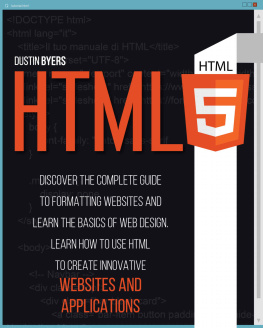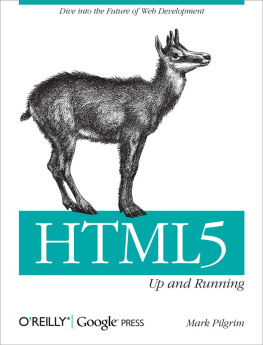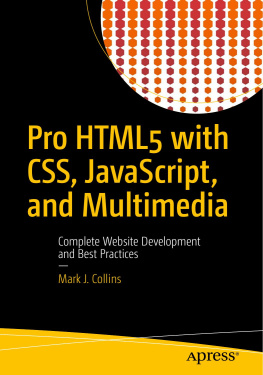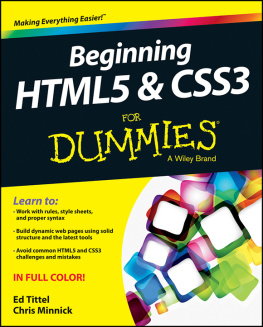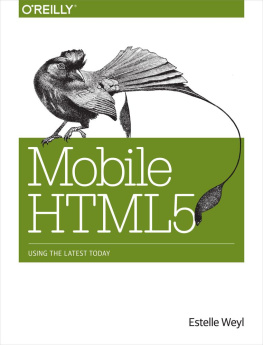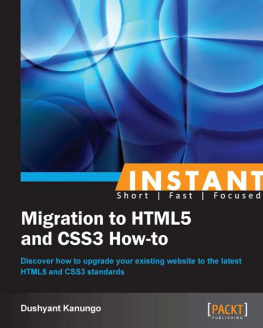HTML5
DISCOVER THE COMPLETE GUIDE TO FORMATTING WEBSITES AND LEARN THE BASICS OF WEB DESIGN. LEARN HOW TO USE HTML TO CREATE INNOVATIVE WEBSITES AND APPLICATIONS
Dustin byers
INDEX
tag
The tag
Copyright 2021 by Dustin Byers
All rights reserved. Reproduction, even partial, in any form or means is prohibited without the express written permission of the Author.
Legal Notice
The content and information in this book is provided for educational and recreational purposes only. The contents offered have been drafted with the utmost care/diligence and subjected to careful control. The Author, however, declines all responsibility, direct and indirect, towards users and any third party in general, for any inaccuracies, errors, omissions, damages (direct, indirect, consequential, punishable and sanctionable) deriving from the aforementioned contents.
Introduction
The purpose of this guide is not only to teach you how to format in HTML5, but also to provide a critical look at programming by explaining the behind the scenes beyond the screen we use every day. Why?
Because everything around us is based on programming. In the era of technology, we all have to deal with this world unknown to most. We all interact with the code, not just the insiders. Our perception of the world is now strongly influenced by increasingly advanced technological tools. We use devices that contain an incredible concentration of human intelligence in a completely passive way.
Think about it.
You bought this book by placing an order online. You paid a bill through a website. In just one day, you can perform countless actions thanks to technology. Not to mention the abuse of smartphone use. According to a Lancaster University study published in the journal Plos One, we use it on average five hours a day , looking at it 85 times over the course of 24 hours. About a third of the time we spend awake is spent looking at the phone. The disturbing aspect is that the perception of its use is totally distorted. People control it twice as much as they think they do.
At this point I would say that we can write down the first good reason to learn at least the basics of programming:
- Stop being a passive user of technology.
Some argue that programming will be a fundamental skill almost like reading and writing. In fact, code is the language of machines and machines increasingly play the role of intermediaries between us and the world. Learning this new language means gaining awareness of the mechanisms that govern the era of technology. The more aware you are, the less a slave you are to an often unjust system.
Talking like a machine allows you to "think" like a machine. Here is the second good reason:
- Knowing how to program means knowing how to think differently.
But what exactly does it mean to program?
Programming means writing a series of instructions that will be read, interpreted and executed. Basically, programming is sustaining a conversation. The purpose of this conversation is to create something that is functional to our purpose.
To do this, it takes order.
As the legal system regulates the development of social life and the relationships between individuals, even in computer science there is a set of rules to be respected. If the rigor is lacking, the intended objective will not be achieved. A small mistake is enough to jeopardize our work. In computer science there is no place for imprecision.
- Programming offers you the right method to unravel situations and solve problems with rigor and meticulousness.
I hope this brief introduction has helped us understand the world we are about to dive into.
I can't wait to take you on this journey!
Chapter 1. What is HTML?
What HTML is not
Let's start with what HTML is not . HTML is not a programming language. How? And the whole premise about programming?
You are right but, although it is not a programming language, it remains essential in web-oriented programming. It will therefore be the basis from which to start, the foundation of our work.
HTML stands for HyperText Markup Language . It is, therefore, a markup language useful for formatting documents often created to be viewed with browsers. This is why it is good to talk about a formatting (or markup) language rather than a programming language.
The expression "markup language" refers to a language that allows you to describe data through specific formatting. This formatting is possible through the aforementioned markers. In HTML we will refer to markers with the name tag .
A bit of history
The HTML project was born in 1989 thanks to Tim Berners-Lee together with the HTTP protocol. The development was completed and made public in 1993 at CERN in Geneva. The world knows the first formal definition of HTML and the HTTP protocol, the two tools that have brought the Internet to every corner of the planet. In the 90s the World Wide Web spread rapidly thanks to the birth of commercial browsers. The first browser to enter homes was Netscape, followed by Microsoft's Internet Explorer which for about ten years had the hegemony of the Web.
We are talking about a public domain language which has now reached its fifth version. The syntax of HTML is established, edited and reviewed by the World Wide Web Consortium (W3C).
A bit of order
I do not want to confuse you from the first chapter with terms which, perhaps, you do not fully understand. Let's make our life easier by schematizing and reviewing the various technical terms used so far.
- WWW .
Although it is used daily, many of the people do not even know the literal meaning of the World Wide Web.
First of all, the Web is not the Internet . Indeed, the Web is only one (certainly among the most important) of the many services offered by the Internet. Basically it allows us to browse and reach contents connected to each other through the famous links . This is what the famous "network" we are talking about is. Obviously it would not be so intuitive to reach the aforementioned contents without a Browser and a network protocol;
- Internet .
The Internet is a telecommunications network . What is a telecommunications network? It is the set of devices, transmission channels and procedures through which two or more users, located in different geographical positions, can exchange information. This information is transferred and received through a common network protocol suite called "TCP/IP". TCP and IP are the most important (but not the only) protocols used because they are in fact the language in which computers connected to the Internet (called "hosts") communicate with each other. It is such a widespread public access network that it connects devices all over the world. To help us, we can think of the Internet as the telephone network. Both are worldwide and publicly accessible;
- Client-Server Architecture.
Indicates a network architecture in which a client computer connects to a server to use a certain service.
More simply, by limiting the concept to the web, we can say that servers are the computers that contain the physical files that make up websites, and that, through the Web, allow access to clients.
What does it mean to allow access to the client?
Whenever a content or service is requested by browsing the web, a return trip is made. From a Client (e.g. computer, tablet, smartphone, etc ...) connected to the Internet, it is possible to request content from a Server which returns the requested content to the Client.

Next page
